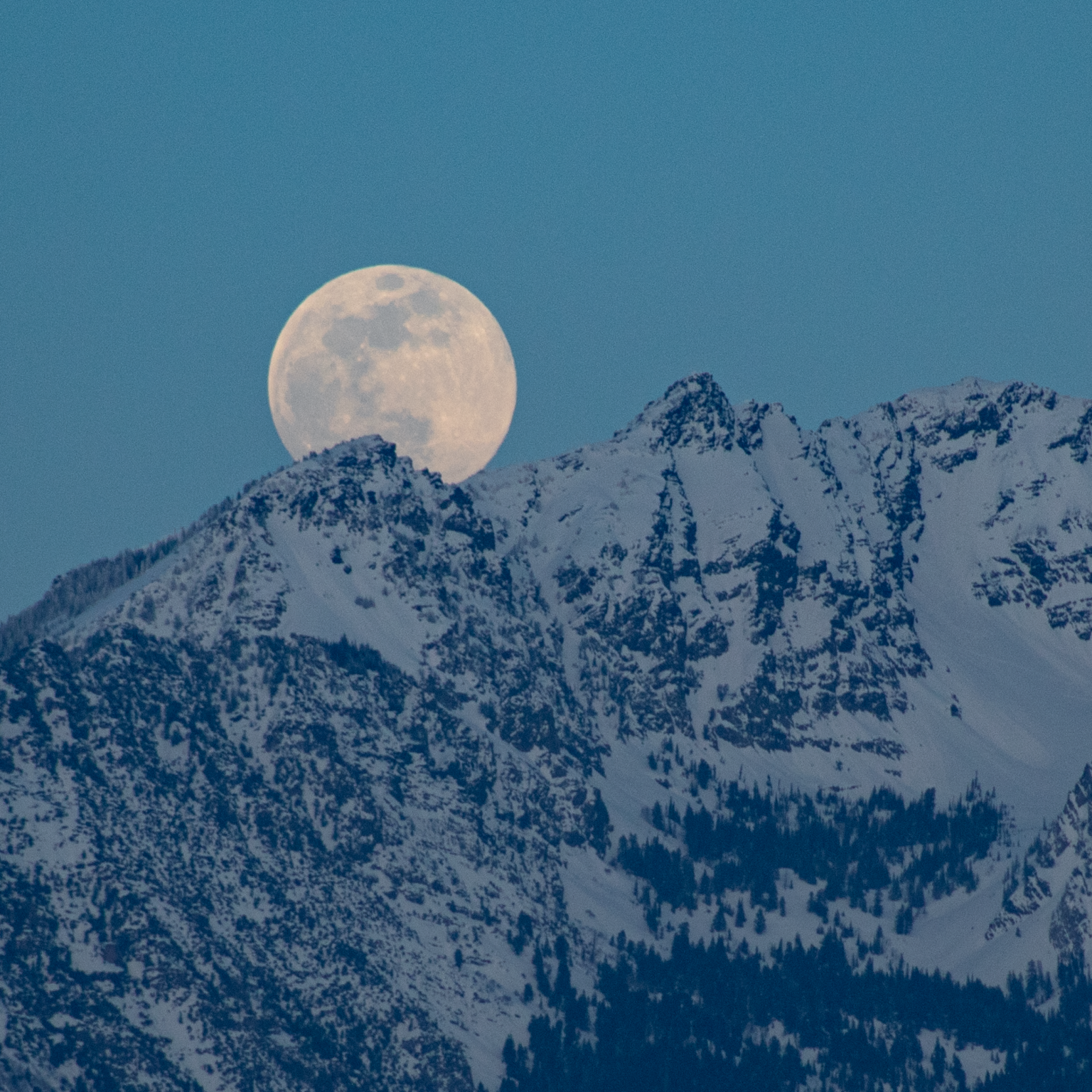
NASA/Bill Dunford
The next full moon is the Crow, Crust, Sap, Sugar, or Worm Moon; the Paschal Moon; Purim; the Holi Festival Moon; Madin Poya; the Pothole Moon; a Micromoon, and a Partial Lunar Eclipse.
The next full moon will be on Monday morning, March 25, 2024, appearing opposite the Sun in Earth-based longitude at 3 AM EDT. This will be on Sunday evening from Alaska Time westward to the International Date Line. Around this time the Moon will pass through the partial shadow of the Earth (called a penumbral lunar eclipse). The slight dimming of the Moon will be difficult to notice, but see if you can tell if the lower part of the Moon is dimmer than the upper part. The Moon will begin entering the Earth's shadow at 12:53 AM, reach greatest eclipse at 3:13 AM with 96% of the Moon in partial shadow, and exit the shadow at 5:32 AM. Since this full Moon is a little over a day after apogee (when the Moon is at its farthest from the Earth in its orbit) this is a micromoon, the opposite of a supermoon. The Moon will appear full for about 3 days around this time, from Saturday evening through Tuesday morning.
The Maine Farmers' Almanac began publishing "Indian" names for full Moons in the 1930s and these names are now widely known and used. According to this almanac, as the full Moon in March the tribes of the northeastern United States called this the Crow, Crust, Sap, Sugar, or Worm Moon. The more northern tribes of the northeastern States knew this as the Crow Moon, with the cawing of crows signaling the end of winter. Other northern names were the Crust Moon, because the snow cover became crusted from thawing by day and freezing by night, or the Sap (or Sugar) Moon as this was the time for tapping maple trees. The more southern tribes called this the Worm Moon after the earthworm casts that appeared as the ground thawed. It makes sense that only the southern tribes called this the Worm Moon. When glaciers covered the northern part of North America they wiped out the native earthworms. After these glaciers melted about 12,000 years ago the more northern forests grew back without earthworms. Most of the earthworms in these areas are invasive species introduced from Europe and Asia.
In the western Christian ecclesiastical calendar this is the Paschal Moon, from which the date of Easter is calculated. Paschal is the Latinized version of Pesach, Hebrew for Passover. Initially, the Christian holiday of Easter, also called Pascha, was celebrated on the first Sunday after the first full Moon of spring. However, there are differences between the times of these astronomical events and the calendars now used by the Eastern and Western churches. Western Christianity will be celebrating Easter on Sunday, March 31, 2024, the Sunday after this first full Moon of spring. The date of Eastern Orthodox Easter is based on the Julian calendar and will be on Sunday, May 5.
Many lunar and lunisolar calendars start the months on the new Moon with the full Moon in the middle of the month. Lunisolar calendars add or repeat a month as needed to keep the lunar months aligned with the solar seasons. This full Moon is in the middle of the second month of Adar in the Hebrew calendar and corresponds with Purim, celebrated from sunset on March 23 to sunset on March 24, 2024, the 14th of the Adar II (a day later in Jerusalem and ancient walled cities). Purim marks the Jewish people’s deliverance from a royal death decree around the fourth century BCE as told in the Book of Esther. Purim is celebrated by exchanging gifts of food and drink, feasting, and donating to charity.
In the Islamic calendar this full Moon is near the middle of the holy month of Ramadan. Ramadan is honored as the month in which the Quran was revealed. Observing this annual month of charitable acts, prayer, and fasting from dawn to sunset is one of the Five Pillars of Islam.
As the full Moon in the Hindu month Phalguna, this Moon corresponds with the Holi festival, celebrating the victory of good over evil and the start of spring. This two-day long festival is also known as the Festival of Love, Festival of Colors, or the Festival of Spring. Holi begins with a bonfire the evening before the day of the full Moon, continues on the day of the full Moon with a free-for-all game involving the spraying of colored powders and/or colored water on whomever wanders by, and ends with evening visits with friends and family.
Every full Moon is a holiday in Sri Lanka. This full Moon is Medin or Madin Poya, marking the Buddha's first visit to his father after his enlightenment.
Continuing the tradition of naming Moons after prominent phenomena tied to the time of year, a few years ago my friend Tom Van Wagner suggested naming this the Pothole Moon. It may be a case of confirmation bias, but whether in my car or on my bicycle I notice more potholes this time of year.
As usual, the wearing of suitably celebratory celestial attire is encouraged in honor of the full Moon.
As for other celestial events between now and the full Moon after next (with specific times and angles based on the location of NASA Headquarters in Washington, DC):






